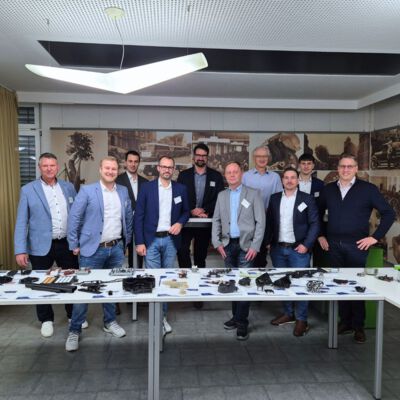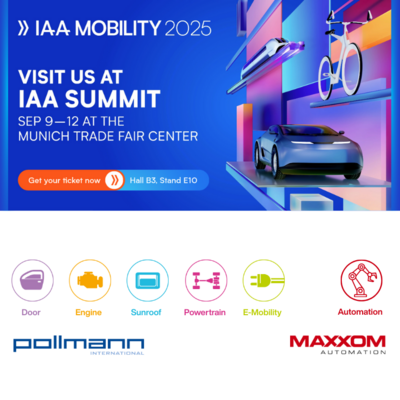News
Pollmann Launches New Tech-Day Format
More
Home Popular

Innovation Popular

Compliance Popular

Realization Popular

Trainee Program Popular

Prototypes Popular

Advanced Product Quality Engineer Full-time

Pollmann Launches New Tech-Day Format 15. December 2025

Pollmann & MAXXOM at IAA MOBILITY 2025 27. August 2025

Pollmann presents initial review of the Vitis relocation 21. August 2025

Matthias Haider Takes Over as CFO at Pollmann International 24. July 2025

Pollmann is once again a “Leading Employer” 28. April 2025

Pollmann optimizes European production footprint 03. April 2025
The US is still considered the land of limitless opportunities, and that also applies to individual mobility. There is hardly any other place where motorists drive longer distances, where the brawny, gas-guzzling pick-up truck is such an obvious status symbol and where old white men (and they are not the only ones) insist more fiercely on their right to use as much crude oil as they please.
But there is another side to the coin: After China, the United States is the world’s largest market for electric drives and home to countless green think tanks. e-Mobility pioneer Tesla in Silicon Valley may be the most famous, but is by no means the only one.
Nine US states - California, Oregon, Maryland, New York, New Jersey, Connecticut, Vermont, Massachusetts and Rhode Island - prepared e-Mobility action plans 18 months ago which are supposed to lead to a massive increase in the registration of electric vehicles and hybrids.
Front runner Tesla
However, of the 17 million new car registrations in the US last year, a mere 326,644 or about two percent were for electrically driven cars. This means that the US is still a long way from a massive shift to e-cars. However, compared to Germany, where about 1.8 percent of new car registrations were for e-cars in 2019 and to Austria with 2.8 percent, the US isn’t doing too badly. In Tesla’s home state California, newly registered electric cars account for an impressive eight percent of total registrations.
Last year, the Californian front runner sold about 190,000 vehicles or more than half of all e-vehicles sold in the US. This can be largely attributed to the model 3 with more than 155,000 sold, followed by models X and S. Worldwide, Tesla sold just short of 368,000 cars in 2019. This means that the US is still the e-car pioneer’s largest market. About 51 percent of the cars produced in Fremont, California are sold on the home market.
Challenges on the home market
However, Elon Musk may soon face serious competition from US manufacturer GM and its Chevrolet, Hummer and Cadillac brands. In early March, General Motors CEO Mary T. Barra announced that the company will roll out twenty e-models by 2023, and its 2025 goal is to sell a million electric cars, primarily in the US, but also in China. Barra explains the reason for this decision: “Climate change is a reality for us. That is why we want to put as many electric cars as possible on the road. We have the opportunity and means to make our planet cleaner and healthier.”
Tesla, founded in 2003, has had a few profitable quarters, but has not once ended a full fiscal year in the black. Barra, on the other hand, announced that her company’s electric segment will be profitable from the very outset.
Electric advertising campaign
With the exception of California, electric cars have not yet been able to reach a wider audience in the US, which is why they have not shown much of a profit. Mark Wakefield, Managing Director at consulting firm AlixPartners, attributes this to the limited demand for such vehicles. And to the lack of a compelling story. As he puts it, “Until now, the narrative was: You must give up your Diesel or gasoline engine in order to save the world.” According to Wakefield, this is going to change now. The new strategy is to emphasize the coolness of electric cars, which should generate enough demand to make a Profit.
He may have a point, looking at the commercials which were booked for this year’s Super Bowl. The Super Bowl, the annual championship game of the US National Football League, is a major media event, and the day of the championship is one of the most important advertising days of the year. The Super Bowl is an excellent indicator to find out which topics are currently high on the list of advertisers.
The commercials placed by the automotive industry at this year’s Super Bowl can tell us a lot. Of the total number of advertisers, eight companies came from the automotive sector, which has been about average for many years. However, the fact that three of them ran commercials for electric cars is seen by observers as a trend shift and a sign that manufacturers clearly want to focus more heavily on the electric segment.

Share this article
We'll be glad to answer your questions:

We'll be glad to answer your questions:

Ms.
Jasmin Schön
Marketing & Communication
Pollmann International GmbH
Raabser Straße 1
3822 Karlstein / Thaya
Austria